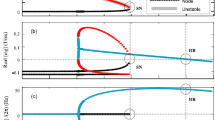Abstract
The present work derives the spatiotemporal field equation of neural populations considering two types of neurons. The model considers pyramidal cells, which may excite or inhibit other neurons, and GABAergic interneurons inhibiting terminal neurons. Additionally, taking into account excitatory and inhibitory synapses, the neural population obeys a vector-field equation involving nonlocal spatial interactions. The work studies the effect of the anesthetic agent propofol, which increases the decay time of inhibitory synapses. In addition, it explains the bifurcation mechanism in some detail and finds a saddle–node bifurcation subject to the propofol concentration. This bifurcation may model the transition between consciousness and nonconsciousness and vice versa during the administration of general anesthetics in medicine.




Similar content being viewed by others
References
Haken, H.: Brain Dynamics. Springer, Berlin (2008)
Bressloff, P., Cowan, J., Golubitsky, M., Thomas, P., Wiener, M.: What geometric visual hallucinations tell us about the visual cortex. Neural Comput. 14, 473–491 (2002)
Ermentrout, G.B., Cowan, J.D.: A mathematical theory of visual hallucination patterns. Biol. Cybern. 34, 137 (1979)
Coombes, S.: Waves, bumps and patterns in neural field theories. Biol. Cybern. 93, 91–108 (2005)
Frank, T., Daffertshofer, A., Peper, C., Beek, P., Haken, H.: Towards a comprehensive theory of brain activity: coupled oscillator systems under external forces. Physica D 144, 62–86 (2000)
Wallenstein, G.V., Kelso, J.A.S., Bressler, S.L.: Phase transitions in spatiotemporal patterns of brain activity and behavior. Physica D 84, 626–634 (1995)
Steyn-Ross, M., Steyn-Ross, D.: Theoretical electroencephalogram stationary spectrum for a white-noise-driven cortex: evidence for a general anesthetic-induced phase transition. Phys. Rev. E 60(6), 7299–7311 (1999)
Steyn-Ross, M., Steyn-Ross, D., Sleigh, J., Wilcocks, L.: Toward a theory of the general-anesthetic-induced phase transition of the cerebral cortex: I. A thermodynamic analogy. Phys. Rev. E 64, 011911 (2001)
Baker, P., Pennefather, P., Orser, B.: Disruption of coherent oscillations in inhibitory networks with anesthetics: role of GABA-A receptor desensitization. J. Neurophysiol. 88, 282–2833 (2002)
Kitamura, A., Marszalec, W., Yeh, J., Narahashi, T.: Effects of halothane and propofol on excitatory and inhibitory synaptic transmission in rat cortical neurons. J. Pharmacol. 304(1), 162–171 (2002)
Rundshagen, I., Schroeder, T., Prochep, I., John, E., Kox, W.: Changes in cortical electrical activity during induction of anesthesia with thiopental/fentanyl and tracheal intubation: a quantitative elecroencephalographic analysis. Br. J. Anaesth. 92(1), 33–38 (2004)
Freeman, W.: Tutorial on neurobiology: from single neurons to brain chaos. Int. J. Bifurc. Chaos 2(3), 451–482 (1992)
Bojak, I., Liley, D.: Modeling the effects of anesthesia on the electroencephalogram. Phys. Rev. E 41, 041902 (2005)
Robinson, P., Rennie, C., Wright, J.: Propagation and stability of waves of electrical activity in the cerebral cortex. Phys. Rev. E 56(1), 826–840 (1997)
Hutt, A., Atay, F.M.: Analysis of nonlocal neural fields for both general and gamma-distributed connectivities. Physica D 203, 30–54 (2005)
Wilson, H., Cowan, J.: Excitatory and inhibitory interactions in localized populations of model neurons. Biophys. J. 12, 1–24 (1972)
Abeles, M.: Corticonics. Cambridge University Press, Cambridge (1991)
Nunez, P.: Neocortical Dynamics and Human EEG Rhythms. Oxford University Press, New York (1995)
Hutt, A.: Generalization of the reaction-diffusion, Swift-Hohenberg, and Kuramoto-Sivashinsky equations and effects of finite propagation speeds. Phys. Rev. E 75, 026214 (2007)
Acknowledgements
The authors would like to thank Michael Zaks for valuable discussions and acknowledge the financial support by the Deutsche Forschungsgemeinschaft (SfB-555).
Author information
Authors and Affiliations
Corresponding author
Rights and permissions
About this article
Cite this article
Hutt, A., Schimansky-Geier, L. Anesthetic-Induced Transitions by Propofol Modeled by Nonlocal Neural Populations Involving Two Neuron Types. J Biol Phys 34, 433–440 (2008). https://doi.org/10.1007/s10867-008-9065-4
Received:
Accepted:
Published:
Issue Date:
DOI: https://doi.org/10.1007/s10867-008-9065-4




